3-movers
More-movers
Studies
Helpmates
Selfmates
Fairies
Letter N° 1
Letter N° 2
Letter N° 3
Letter N° 4
Letter N° 5
Letter N° 6 New
A: 2-movers
Judges: Netherland, Yugoslavia, Slovakia, Ukraine, Great Britain.
Reserve judge: France
Single-phase 2-movers with a blend of at least three different thematic groups of two or more variations, i.e. at least 6 variations altogether. Two of the thematic groups may show the same theme but must be clearly recognisable as separate systems. There should be different mates in all thematic variations, and none of the thematic variations should appear in more than one thematic group.
|
J. Roura
Good Companion 1919 |
F. E. Gogfrey
Good Companion 1917 1. Prize |
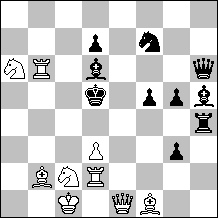
|
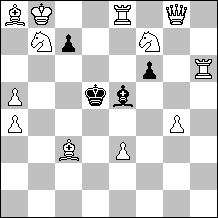
|
|
2# 9 + 10
|
2# 6 + 5
|
|
1.Qe8 ! ( 2.Se3# ) 1... Re4 2.dxe4# 1... Rc4 2.dxc4# 1... f4 2.Qe4# 1... g4 2.Bg2# 1... Bc5 2.Sc7# 1... Bf4 2.Scb4# |
1.Bd2 ! 1... c6+ 2.Sfd6# 1... c5 2.Sbd6# 1... B~ 2.Sfd8# 1... f5 2.Sg5# 1... Kc4 2.Sxe5# 1... Kc6 2.Sxe5# 1... Ke4 2.Sc5# |
V. Marin Y Llovet
Good Companion 1921 |
M. Pfeifer
Chwila 1932 Special Prize |
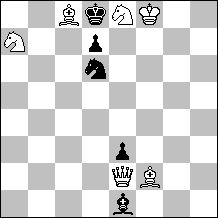
|
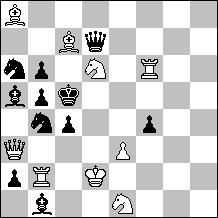
|
|
2# 6 + 5
|
2# 9 + 11
|
|
1.Qd2 ! tempo 1... Bxd2 2.Bh4# 1... Bxf2 2.Qa5# 1... exf2 2.Qg5# 1... exd2 2.Bb6# 1... S~ 2.Qxd7# 1... Sxc8 2.Sc6# |
1.Qc3 ! ( 2.Qd4# ) 1... Sd3 2.Se4# 1... Sd5 2.Sb7# 1... Sc2 2.Sd3# 1... Sc6 2.Rxb5# 1... fxe3+ 2.Qxe3# 1... Qxd6+ 2.Bxd6# |
G. P. Latzel
La Domenica dei Giochi 1932 1. Prize |
C. Mansfield
Svening Standard 1929 1. Prize |
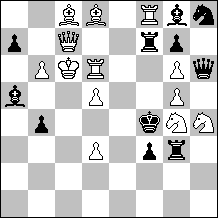
|
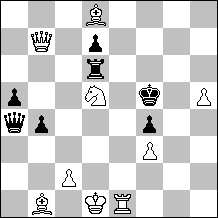
|
|
2# 13 + 11
|
2# 9 + 7
|
|
1.Kb7 ! ( 2.Rc6# ) 1... Rf6 2.Qc1# 1... Rf5 2.Qc4# 1... Qxg5 2.Rf6# 1... Rxg4 2.Re6# 1... Bxb6 2.Rxb6# 1... Qxg6 2.Rxg6# 1... Sxg6 2.Rxg6# |
1.Qb5 ! ( 2.Qd3# ) 1... Qxb5 2.c4# 1... Qa3 2.c3# 1... Re6 2.Se3# 1... Rf6 2.Se7# 1... Qxc2+ 2.Bxc2# 1... Rxd5+ 2.Qxd5# |
|
M. Abadashew
Konk. Moldavian SSR 1935 1. Prize |
L. Loshinski & V. Shiff
Sverdlovsk Sport commitee 1946 Commendation |
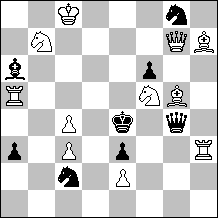
|
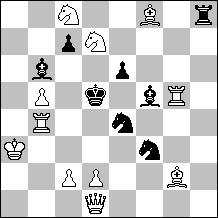
|
2# 11 + 8
|
2# 11 + 8
|
| 1.Qc7 ! ( 2.Qc6# ) 1... Qxg5 2.Sg3# 1... Qxe2 2.Sfd6# 1... Bb5 2.Sc5# 1... Bxc4 2.Sbd6# 1... Qxf5+ 2.Bxf5# 1... Bxb7+ 2.Qxb7# 1... Se7+ 2.Qxe7# |
1.c3 ! ( 2.Qb3# ) 1... Sfxd2 2.Bxe4# 1... Sexd2 2.Bxf3# 1... Sc5 2.Rd4# 1... Se5 2.Sf6# 1... Sd4 2.c4# 1... Sd6 2.Se7# |
M. R. Vukcevich
Schach-Echo 1976 |
M. R. Vukcevich
Chess in Milan 1981 (v) |
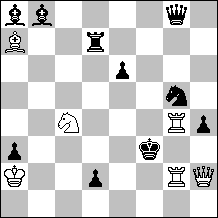
|
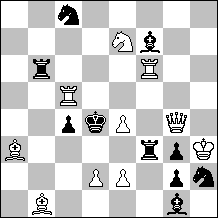
|
2# 6 + 10
|
2#1 10 + 10
|
|
1.Qd6 ! ( 2.Sxd2# , Se5# ) 1... Rxd6 2.Se5# 1... Bxd6 2.Sxd2# 1... Rxa7 2.Qd3# 1... Bxa7 2.Qf4# 1... e5 2.Qf6# 1... Bd5 2.Qxa3# |
1.Qg7 ! ( 2.Rd6# ) 1... Rd3 2.Re6# 1... Rxa3 2.Rfc6# 1... Rxb4 2.Rff5# 1... Rxb1 2.Rf4# 1... Rfxf6 2.Sf5# 1... Rbxf6 2.Sc6# |
B: 3-movers
Judges: Czech republic, Netherland, Germany, Romania, Ukraine.
Reserve judge: Italy
A white piece ( not a pawn ) is unpinned by Black’s first move and immediately sacrifices itself, i.e. plays to a square where it is exposed to capture.
|
Marek Kwiatkowski
Wola Gulowska 2000 Commendation |
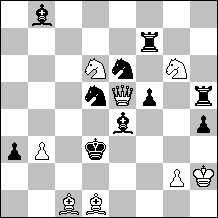
|
|
3# 8 + 10
|
|
1.Sb5 ! ( 2.Sf4+ Sexf4 3.Qd4# 2...Sdxf4 3.Qc3# ) 1... Ba7 2.Qc3+ Sxc3 3.Se5# 1... Rc7 2.Qd4+ Sxd4 3.Se5# 1... f4 2.Qxe4+ Kxe4 3.Bc2# |
C: More-movers Judges: Netherland, Germany, Austria, Russia, Sweden.
Reserve judge: Romania
Direct-mates in 4 or more moves in which a white piece vacates square X to allow another white piece to occupy that same square X at least 2 moves later ( i.e. White must wait at least one move after the vacation of square before be occupies it by another piece ). A pawn may be used as a thematic piece(s).
|
Alois Johandl
Freie Presse 1998 1. Prize |
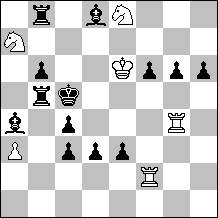
|
|
7# 6 + 13
|
|
1.Rd4 ! ( 2.Rd5# ) 1... Kxd4 2.Rf4+ Kc5 3.Sd6 ( 4.Rxc4# ) 3... Rb4 4.Se4+ Kd4 5.Sf2+ Kc5 6.Sxd3+ cxd3 7.axb4# |
D: Studies Judges: Belgium, Georgia, Israel, Romania, Russia.
Reserve judge: Belarus In a certain position („position X“) of a win or draw study, a piece (or pieces) of his own side prevent White from carrying out his plan. In the course of the solution White sacrifices this piece (or pieces) either passively ( example 1 and 3 ) or actively ( example 2 ). Consequently, position X, arises, which is identical in every detail to position X, but without the eliminated piece(s). This enables White to carry out his original plan. In examples 1 and 2, position X is the diagram position ; in example 3, position X occurs after Black’s 1st move. Pawn(s) may be used as the thematic piece(s).
I. Kozlowski
Swiat Szachowy 1931 |
Y. Afek
Themes-64 1977 2. Commendation |
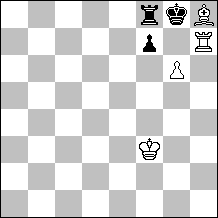
|
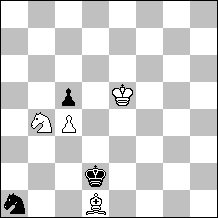
|
| + 4 + 8
|
+ 4 + 3
|
|
1.g7 ? R~ ! 1.Rg7+ ! Kxh8 2.Rh7+ Kg8 3.g7 ! |
1.Ba4 ? cxb4 2.c5 b3 3.Bxb3 Sxb3 draw ( 4.c6 Sa5 5.c7 Sc6+ ) 1.Sc2 ! Sb3 2.Sa1 !! ( 2.Se3 Sa5 draw ) Sxa1 3.Ba4 Kc3 4.Kd5 Kb4 5.Bd1 wins |
David Gurgenidze
Die Schwalbe 1995-1996 2. Prize |
|
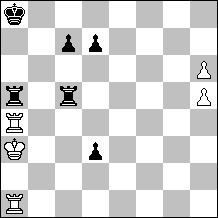
|
|
|
+ 5 + 6
|
|
|
After: 1.Kb4 Rb5+, the thematic try: 2.Kc3? Rc5+ 3.Kd2 Rxa4 4.Rxa4+ Kb7 5.Rh4, allows 5. Rc6 6.h7 Rh6 ! Therefore 2.Kc4 ! Rc5+ 3.Kd4 Rd5+ 4.Ke4 Re5+ 5.Kf4 Rf5+ 6.Kg4 Rg5+7.Kh4 Rxh5+ 8.Kg4 Rg5+ 9.Kf4 Rf5+ 10.Ke4 Re5+ 11.Kd4 Rd5+ 12.Kc4 (12.Kc3 ? Rxa4 13.Rxa4+ Kb7) 12... Rc5+ 13.Kb4 Rb5+, and the original plan succeeds: 14.Kc3! Rc5+ 15.Kd2 Rxa4 16.Rxa4+ Kb7 17.Rh4, and since wPh5 has been eliminated (passively sacrificed), 17. Rc6 (for Rh6) is now to no avail. |
E: Helpmates Judges: Bosnia-Herzegovina, Greece, Switzerland, Sweden, Italy.
Reserve judge: Great Britain
Helpmates in 3 are required with (at least) two phases where:
In phase 1 the move of a piece X has a certain effect “e" (line-opening, line-closing, pin, unpin,capture,etc.) with respect to an adversary (opposite-colour) piece Y. In phase 2 the move of piece Y has the same effect "e" with respect to piece X. See basic pattern and other allowed alternatives below (where Xs belong to one side, Ys belong to the opposite side).
Pattern A (basic pattern):
Phase 1: the move of X has the effect “e” with respect to Y
Phase 2: the move of Y has the effect “e” with respect to X
A cyclic expression is permitted, as in the following pattern:
Pattern B: Phase 1: the move of X1 has the effect “e” with respect to Y1
Phase 2: the move of Y1 has the effect “e” with respect to X2
Phase 3: the move of X2 has the effect “e” with respect to Y2
Phase 4: the move of Y2 has the effect “e” with respect to X1
A splitting is also permitted, as in the following patterns:
Pattern C: Phase 1: the move(s) of X has the effect “e1” and “e2” with respect to Y
Phase 2: the move of Y has the effect “e1” with respect to X
Phase 3: the move of Y2 has the effect “e2” with respect to X
Pattern D:
Phase 1: the move of X has the effect “e1” with respect to Y1 and “e2” with respect to Y2
Phase 2: the move of Y1 has the effect “e1” with respect to X
Phase 3: the move of Y2 has the effect “e2” with respect to X
A doubling, tripling, etc. of the theme in any way, and a combination or condensation of the above-mentioned patterns are allowed. Pawn(s) may be used as the thematic piece(s). Set-play, twinning and multi-solutions are permitted, but zeropositions or duplex settings are not allowed.
|
Thomas Maeder
Idee&Form 1991 Commendation |
Thomas Maeder
Idee&Form 1991 |
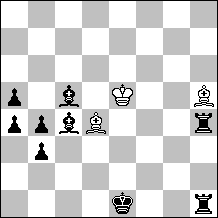
|
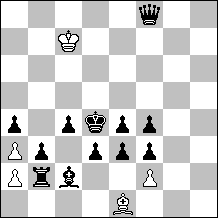
|
|
h3# 2 solutions 3 + 9
|
h3# * 5 + 12
|
|
1.Bf1 Bg1 2.Be3 Bh2 3Bd2 Bg3# 1.Ba7 Bb6 2.Rf1 Bxa5 3.Bf2 Bxb4# |
1.... Ba5 2.Qb4 2.fxe3+ Kc3 3.Bxb4# 1.Qxa3 Bb4 2.bxa2 Kd6 3.Qc3 Bc5# Critical move and interception (once with Maslar theme) |
|
Christopher J. A. Jones
The Problemist 2000 |
T. Maeder & M. M. Manhart & F. Pachl
Schach-Report 1992 3. Prize |
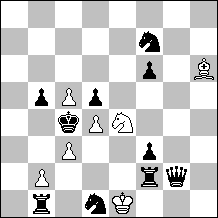
|
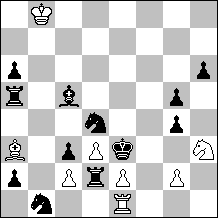
|
|
h3# 2 solutions 7 + 10
|
h2# 4 solutions 8 + 12
|
|
1.Rc2 Bd2 2.f2+ Ke2 3.Rxd2+ Sxd2# 1.Kd3 Bc1 2.Rd2 Sf2+ 3.Ke3 Bxd2# Maslar theme |
1.Rxe2 Bb2 2.Sa3 Bc1# 1.Rxd3 Bxc5 2.Sd2 exd3# 1.Sxe2 Bb4 2.Ra3 Bxc5# 1.Sf3 Bc1 2.Bd4 exf3# Rd2 takes Pe2, Pe2 takes Rd2 Sd4 takes Pe2, Pe2 takes Sd4 Duplication of the theme |
Gabor Cseh
Harmonie 1996 |
|
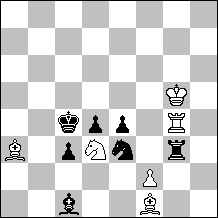
|
|
|
h2# 6 + 7
B: whole position 3 rows up |
|
|
A: 1.Sd5+ f4 2.exf3 ep+ Sxc1# B: 1.Sd8+ Sxc4+ 2.e5 fxe6 ep# |
F: Selfmates Judges: France, Israel, Germany, Russia, USA.
Reserve judge: Bulgaria
Selfmates in 3 to 7 moves in Which – not on his last move – sacrifices a piece (not a pawn) to be captured, immediately or subsequently, by the black King. Arrival of the thematic piece on the sacrificial square during the solution is a requirement. A sacrifice on White's last move will be regarded in the same way as any other non-thematic move, but the black capture of the piece thematically sacrificed may occur on any move.
|
Uri Avner
The Problemist 1992 1. Prize |
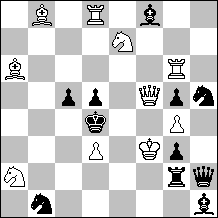
|
s6# 10 + 11
|
|
1.Qc8 ! ( 2.Qxc5 + Kxc5 3.Rc8+ Kd4 4.Sc6+ Kc5 5.Scb4+ Kd4 6.Sc2+ Rxc2# ) 1... Bxe7 2.Rxd5 Kxd5 3.Qf5+ Kd4 4.Be5+ Kd5 5.Bxg3 Kd4 6.Bf2+ Rxf2# 1... Sf6 2.Be5+ Kxe5 3.Rxg5+ Kd4 4.Sf5+ Ke5 5.Sxg3+ Kd4 6.Se2+ Rxe2# |
G: Fairies Judges: France, Yugoslavia, Slovakia, Slovenia, Great Britain.
Reserve judge: Switzerland
Direct-mates in 3 or move moves with the conditions “one set of chessmen”: a pawn can promote only to a piece whose equivalent has already been removed to from the board by capture. Either side may have 2 Bishops on squares of the same colour, but neither side can ever have 3 Bishops or 2 Queens at the same time. The way the condition is applied defines the type of problem:
Type 1: A pawn on the 7th/ 2nd rank cannot advance to the promotion square until a piece of its side is captured.
Type 2: If a pawn reaches the promotion square before any piece of its own side is captured, whereupon it at once takes the power of that piece. In the case of more than one dormant pawn, the side opponent’s dormant pawns takes the power of the captured piece. A dormant pawn cannot move but may be captured. Composers are free to choose between the two types.
N.N.
|
N.N.
|
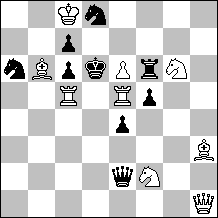
|
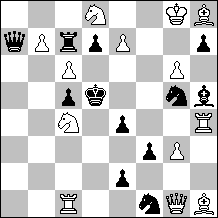
|
|
3# Single box Type 1 9 + 9
|
3# Single box Type 2 13 + 12
|
|
1.e7! ( 2.Se4+ Dxe4 3.e8S# 2... fxe4 3.e8S# ) 1... Qg4 2.Qd1+ Qxd1 3.exd8Q# 1... Re6 2.Red5+ cxd5 3.exd8R# 1... Rf8 2.Bxc7+ Sxc7 3.exf8B# |
1.e8 ! ( 2.Qd4+ cxd4 (e8Q) 3.Qe5# ) 1... Se3 2.Qd1+ Sxd1/exd1 (e8Q) 3.De5# 1... e3 2.Rd4+ 2.cxd4 (e8R) 3.Re5# 1... f2 2.Be4+Sxe4 (e8B) 3.Bf7# 1... d6 2.Se3+ Sxe3 (e8S) 3.Sxc7# 1... Qa1 2.Sb6+ Kd6 3.Qxc5# 1... Sf7 2.Rxh5+ Se5,Sg5 3.Rxe5#,Rxg5# 1... Se6 2.Rxh5+ Sg5 3.Rxg5# |
|
N.N.
|
|
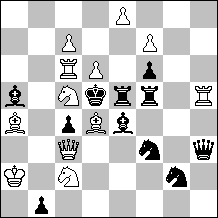
|
|
|
3# Single box Type 2 12 + 11
|
|
|
1.c8 ! (2.Jb4+ Sxb4 (e8J,c8J) 3.Jc7#,Jb6#) 1... Sxc2 (e8J) 2.Jxf6+ Vxf6 (c8J) 3.Je7# 1... Sxc2 (c8J) 2.Je7+ Vxe7 (e8J) 3.Jxf6# 1... Sxc3 (e8D) 2.De6+ Vxe6 (c8D) 3.Dxe6# (b1V) 1... Sxc3 (c8D) 2.De6+ Vxe6 (e8D) 3.Dxe6# (b1V) 1... Sb4 2.Je3+ Jxe3 (e8J,c8J) 3.Jc7#,Jb6# |
Letter N° 1
List of all countries participant in 7 WCCT:
Argentina; Armenia; Austria; Azerbaijan; Belarus; Belgium; BIH; Brazil; Czech; Denmark; England; Finland; France; Georgia; Germany; Greece; Holland; Croatia; Hungary; Israel; Italia; Yugoslavia; Kazakhstan; Latvia; Lithuania; Macedonia; Morocco; Moldavia; Mongolia; Poland; Romania; Russia; Slovakia; Slovenia; Spain; Sweden; Switzerland; Ukraine; USA
Thanks for all applications and successful participate to all teams in this great competition
Questions by Holland:
Section A, 2-movers
Question: The definition goes: "Single-phase 2-movers......"
If a problem has a set play or a try with play of which the content is different from the thematic play in the solution, will that problem be disqualified? That should mean: every problem with setplay and/or tries will be cancelled.
Answer:
The definition states the MINIMUM requirement for a problem to be thematic. Therefore, as long as the problem satisfies this minimum requirement it is thematic. Additional contents by itself (including set, try, etc.) cannot disqualify the problem. It is the judges' duty to decide whether this additional content does or does not add value to the problem.
Section C, more-movers
Question:
"......... in which a white piece vacates square X to allow another white piece to occupy that same square ............." Is it required that the only purpose of the white piece vacating square X, is to allow an other white piece to occupy that square, or is it allowed to the vacating white piece to do also other things (f.i. capturing a black piece that guards the square where white finally mates)?
Answer:
Formally, any vacation, pure or impure in aim, is thematic. However, a convincing exposition of the theme seems to call for a pure, or at least a relatively pure execution. ["Relative purity" means that there are at least two ways to achieve a certain aim (e.g. "capturing a black piece that guards the square where white finally mates"), but only one succeeds because it vacates the thematic square for another white piece to occupy it later.]
Questions by Ukraine:
Section A, 2-movers
1.Does the selfpinning (in this posiition) correspond with thematic identicity? W:Kg6,Tg5,Th1,Lf6,pp.f2,h3 B:Kh4,Dh2,Lh8,Sg3 1.- Dh3: - selfpinning by the Q is pinned by the herself1.- Kh3: - the Q is pinned by the K
2.Does the unpinning correspond with its indencity in the following two-variations? W:Kc1,Sd2,Se1 B: Ka1,Lh6,Sh2,pa2 1.- Lf8 2.Sb3# - direct unpin 1.- Sf2 2.Sc2 - indirect unpin
3.Are the selfblocks identical with the two-variations system of themein the position? W: Kg5,Td1,La7,Sc3 B:Ke5,Td8,Sf8,Pe6 1.- Td6 2.Te1# - simple blocking 1.- Sd6 2.Ld4 - compound blocking
4.Does the following type of blocks correespond with the same thematic group of the 7 WCCT theme? W:Ke7,Th4,Lh3,Pc4,Pf2,Pg3 B:Ke5,Te1,Lb1,Pd4 1.- Te4 2.Th5 - simple self-block 1.- Le4 2.f4# - compound selfblock
Answer: In principle, all 4 cases are acceptable as showing thematic pairs belonging to the same thematic group. However, this is the composer's choice. For example, the composer can legitimately show direct pinning and indirect pinning (a) as belonging to the same thematic group or (b) as belonging to two separate thematic groups. Both choices are allowed.
Section E, helpmates
Is task h#2,5 possible? Answer: Helpmates in 2.5 moves are not allowed.
Director of 7WCCT ZIVKO JANEVSKI
Letter N° 2
Question by Russia
Section A, 2-movers
Question:
The definition goes "Two of the thematic groups may show the same theme but be clearly recognizable as separate systems." But if a problem has 4 systems, may 3 of them show the same theme recognizable as different systems (for example black correction of different pieces)? Will all four systems be accepted as thematic?
Answer: Three thematic groups showing the same theme are not thematic irrespective of the overall number of systems. In the hypothetical case described by the question only two of the three systems showing the same theme (in addition to the system showing a different theme) may be regarded as thematic.
Questions by Great Britain
Section A, 2-movers
Question:
It is this: Must the variations yield only single White mates, or are dual/triple etc. combinations of mates also permitted?
Answer: Multiple combinations of mates that make sense as a thematic system are permitted.
Question:
If dual/triple etc. combinations of mates are permitted after one or more variations within a thematic group, may the same mate appear within the same thematic group, differently combined with other mates; for example in a threefold variation group comprising: after 1...x 2. mates AB, after 1...y 2. mates BC, after 1...z 2.mates AC?
Answer:
Yes, this kind of combination is allowed.
Questions by Yugoslavia
Section A, 2-movers
Question:
All examples present black thematical motives. Does it mean that "white themes" (Albino, white promotions, mates by pinned piece, etc) should be treated as less thematical, or non-thematical?
Answer:
The so called "white themes" (as characterized by the question) are thematic and should be treated in the same manner as "black themes" are treated.
Section C, more-movers
Question:
In the only example, the second thematical white piece could not physically approach the vacated thematical field in less then 2 moves. Is the next example thematical? K.Haneman, 1sr Pr. "Skakbladet", 1953. W:Kf3,Rg1,Be3,Sg5 (4) Bl:Kh2, Ra8,Be5,Sc6,Sd5,Pd4,f4,h3 (8) 1.Ke4! (2.Sf3#) Sf6+ 2.Kf5 Se7+ 3. Ke6 Ra6+ 4.Kf7 and 5.Sf3#, etc. WS could come to the vacated field f3 in the second move, but is prevented to do so till the last move. Is this less thematical or nonthematical example?
Answer:
The immediate threat 2.Sf3 in the Hannemann example is not thematic because it uses the vacation of f3 on the next move. However, the arrival of Sg5 at f3 is thematic on any of the subsequent moves (moves 3,4,5).
Questions by Czech Republic
Section C, more-movers
Question:
Is it allowed for a black piece to enter the thematic square which was released by a white men for another white men? Is it even possible then capture this black piece by entering white men on this thematic square?
Answer:
Yes, this is allowed.
Question:
Is it possible to enter the thematic square by a white men in the mating move?
Answer:
Yes, it is allowed.
Question by Ukraine:
Section G, fairy
Question:
The formulation "one and the only complete set of the chess pieces" can be treated as obligation that 8 pieces from both sides must be present on the chessboard. And only the bishops may be one-squared (one-colored) that is one of them may be promoted. In this case for the legality of the setting there must be not more than seven (7) pawns on the chessboard. If there are seven (7) white pieces on the chess board then it is asked if the pawn on the seventh line can be promoted into the missing piece? Must the concept "the only complete set of the chess pieces" be treated only as reflexial promotion of the pawn of the types (ordinary and sleeping) obligatory following after withdrawing of any piece, present on the diagram?
Answer:
It is not required that all 8 officers (pieces which are not pawns) are present on the board. - If one officer is missing, then a pawn arriving at the promotion rank is immediately (and automatically) promoted to the missing officer. - If more than one officer are missing, then a pawn arriving at the promotion rank is immediately promoted to one of missing officers (as chosen by the promoting side). - If two bishops of the same color are on the board, one of them has obviously been promoted. Thus, 8 pawns on the board are illegal in this case. - A pawn arriving at the promotion rank remains dormant ("sleeping") ONLY when all 8 officers of its color are on the board (NOTE: this refers to Type 2!).
Directotor of 7WCCT ZIVKO JANEVSKI
Letter N° 3
Section D, studies
Question by Poland:
Are the following schemes thematic? 1) White: Kh1 Rd5 Rh5 Bd3 - Black: Kg8 Qb2 Rb8 Bf8 Pf2 Pg7; Win1.Bc4? f1Q+ (Td5 is disturbing). 1.Rh8+ Kh8: 2.Rh5+ Kg8 and the same position arises but without Rd5, although not Rd5 but Rh5 was captured. 3.Bc4# 2) White: Kg3; Qa8; Pa7 - Black: Kg1;Qh6; Rh7; Ph3 - Win 1.Qa1? (Pa7 is disturbing); 1.Qh1+ Kh1: 2.a8Q+ Kg1 and the same position as the initial one arises but without Pa7, although not Pa7 but Qa8 was captured. 3.Qa1+ win.
Answer:
Both cases are not thematic. They satisfy only one part of the theme definition, but not the part that requires the sacrifice (passive or active) of the disturbing piece itself (not its substitute).
Question by Israel:
The definition says:"...Consequently, position X' arises, which is identical in every detail to position X, but without the eliminated piece(s)..."
Question: Does it mean that in positions X and X' the same side must be on move, or is it also possible that in position X one side is on move and in position X' the opposite side is on move?
Answer:
In both positions, X and X', the same side must have the move. Otherwise the theme is not satisfied.
Remark: For this reply we have adopted paragraph 9.2 of the FIDE Rules of Chess (approved Istanbul, November 2000) which says:
"Positions are considered the same, if the same player has the move, pieces of the same kind and colour occupy the same squares, and the possible moves of all the pieces of both players are the same. Positions are not the same if a pawn that could have been captured en passant can no longer is captured or if the right to castle has been changed temporarily or permanently."
Directotor of 7WCCT ZIVKO JANEVSKI
Letter N° 4
Section A, 2-movers
Question by Belarus:
In the second move of a #2, is a promotion of a pawn into Queen or Bishop is permitted? Example: White : Kg8, Rf5, pp. f6, h5 (4)- Black : Kh6, pd5 (2); #2 1.f7! d4 2.f8=Q# or 2.f8=B#
Answer:
This kind of "dual" promotion is acceptable.
Section A, 2-movers
Question:
All examples present black thematical motives. Does it mean that "white themes" (Albino, white promotions, mates by pinned piece, etc) should be treated as less thematical, or non-thematical?
Answer:
The so called "white themes" (as characterized by the question) are thematic and should be treated in the same manner as "black themes" are treated.
Section E, helpmates
Question by Belarus:
Is it allowed to create a twin by changing the place of a thematic piece?
Answer:
This kind of twinning is not forbidden by the theme definition. It is the judges' duty, however, to consider the artistic value of such a device.
Section F, selfmates
Two questions by Israel:
1. Can a white piece be sacrificed on a square protected by White, so that only after the protection is subsequently removed, the black King is able to capture it?
2. Can a white piece be sacrificed on a distant square, i.e. not at first adjacent to the black King, so that only later in play, after the black King approaches this square, the capture becomes possible?
Answer:
The answer to both questions is YES. These are special cases of anticipatory or delayed sacrifices which are allowed by the theme definition (the theme allows a non-immediate capture of the sacrificed pieces).
Section G, fairies
Question by Germany:
The diagram positions - must they be legal beyond the rules which are pertinent to the Single Box condition? In other words, must there be a proof game - with normal orthodox rules applied - which shows, that the problem position can be reached from the normal initial game array?
Answer:
The history of the diagram position is irrelevant, and no theoretical or practical proof game is needed (only in the case of two Bishops of the same colour, no more than 7 pawns are allowed for the side who has them). The position must be "legal" only in the sense that it follows the definition of the chosen fairy type, e.g. for both types there should not exist on the board at any stage additional pieces to those contained in a "single box" etc. (see theme definition).
Information by Mr. Thomas Maeder
I have built a new executable, which Uri and I have seen run on a variety of computers. Hannu has updated, http://www.sci.fi/~stniekat/pccc/usingpy.htm (thanks!); if you download py-wcct72.exe from the link on that WWW page, you'll get a working Popeye executable ("at least until the next bug appears", says Uri).
Directotor of 7WCCT ZIVKO JANEVSKI
Letter N° 5
Section A, 2-movers
Question by the Netherlands:
Is the following scheme thematic?
1. Key (threat 2.A and 2.B) 1... a 2.A 1... b 2.B.
The Novotny is an example.
Reply: The above pair of variations is a legitimate thematic group.
Section D, studies
Question by Ukraine:
Does the formulation of the theme D let the representation of a position X in a thematic try as in the given below example?
N.Rjabinin, 1998 W: Ka8,Ta1,La2,pp.e2,f6,f7,g7,h3 (8) B: Kh4,Tb4,g3,p.c2 (4) +
1.Lb3? c1D 2.T:c1 Tg:b3 3.Tc7 Tb8+ 4.Ka7 T8b4 5.Tc6 Tb7+ 6.Ka6 T7b4 7.Tc5 Tb6+ 8.Ka5 Tb7 9.Tc4+ Kh5 10.Ka4 Tb1 11.Tc5+ Kh4 12.Tb5 T1:b5 13.f8D Tb1 14.Dh8+ Kg3 15.g8D+ Kh2(X)=; 1.e3 T:e3 2.Lb3 c1D 3.T:c1 Tg:b3 4.Tc7 Tb8+ 5.Ka7 T8b4 6.Tc6 Tb7+ 7.Ka6 T7b4 8.Tc5 Tb6+ 9.Ka5 Tb7 10.Tc4+ Kh5 11.Ka4 Tb1 12.Tc5+ Kh4 13.Tb5 T1:b5 14.f8D Tb1 15.Dh8+ Kg3 16.g8D+ Kh2(X') 17.Da2+
Reply: The theme intended position X to be the diagram position or to occur during the actual solution. This is underlined by the examples. Moreover, there is no mention of the possibility of a try in the theme definition. Therefore, the Rjabinin example cannot be considered thematic.
Section F, selfmates
Questions by USA:
1. Are multiple solutions allowed?
2. Are twins allowed? If so, zeropositions also? Reply: Multiple solutions or twins are not allowed.
Reply: Multiple solutions or twins are not allowed.
Question by USA:
The theme calls for a piece (not a pawn) to be sacrificed and captured by the bK. Suppose there's a wP on e7 and it promotes, say e8=R, and subsequently black plays KxRe8, is that a thematic sacrifice?
Reply: Yes, this is a thematic sacrifice.
Section G, fairies
Questions by USA:
1. Are multiple solutions allowed?
2. Are twins allowed? If so, zeropositions also? Reply: Multiple solutions or twins are not allowed.
Reply: Multiple solutions or twins are not allowed.
Directotor of 7WCCT ZIVKO JANEVSKI
Letter N° 6
WCCT rules
Question by Georgia:
According to the WCCT rules "Any one composer may send three compositions for each section". Some composers interpret this to mean that one composer may send three compositions in total (only three compositions for one section and none for any other section). Question: how many compositions may be sent by one composer in TOTAL?
Reply:
Within the limitation of three entries per section for any participating country, there is no limitation on the number of compositions that one composer may participate with. Theoretically, one composer may participate with 3x7=21 compositions.
Section G - Fairies
Question by Great Britain:
On the question submitted by Israel (Section G) and the reply, I am concerned. Does this reply mean that entries where the logic of the play is dependant on retrograde analysis are not eligible?
Reply:
[This must refer to the question asked by Germany (not Israel), appearing in circular letter no. 4]. True, a retrograde analysis cannot be taken in consideration as part of the problem's content, not only in the Fairies section but for all sections. This has been the case for any previous WCCT (problems with a central retro element seen as belonging to the distinct Retro genre).
IMPORTANT!
All entries for the 7th WCCT must be sent to the Tournament Director by 01.03.2003 (postmark).
I prefer the German notation (KDTLSB).
Below please find a timetable and important information concerning the judging of the 7th WCCT sections. Your attention is directed to (1) the required name, address and e-mail of your country's Judging Coordinator (see below), and (2) the closing date for Protests (15.07.03). Protests should be made only on matters concerning soundness and anticipation. Claims about thematic content will not be accepted. Claims concerning anticipation should be accompanied by the relevant position, solution and source.
Expected Timetable of the 7th WCCT
Instructions and guidance on judging issues from the WCCT subcommittee
Judging Coordinator:
If your country is appointed judge (or reserve judge) in any of the WCCT sections, you are asked to indicate to the director (Zivko Janevski), as soon as possible, the name, address and e-mail of the person nominated by your country with whom communication in all judging matters should be made.
The judging process:
Each judging country is free to determine its own judging method, whether it is one judge, two or three judges. It is recommended that the judges work in consultation with each other to reach the best result. In the case of unresolved dispute among the judges, an appointed person in charge should make the final decision. The most reliable judgements are expected, for which the best experts of the respective country should be appointed.
Point system:
Each entry should be given a numerical score between 0 to 4 points, with half points possible (see guidance table).
WCCT JUDGING: SOME GUIDANCE ON THE AWARD OF POINTS
Basic texts:
The announcement booklet and the circular letters are the framework for thematic matters. Further questions should be addressed to the tourney director, who will deal with them in collaboration with the WCCT subcommittee.
Timetable:
It is expected that judging will be finalised and scores submitted to the director by 1.3.2004 (1st March 2004). To save time, the judging process should begin immediately, even before the stages of protests and replies to protests are concluded (these stages can be taken in consideration later).
Comments by the judging country:
Short comments should be provided for entries receiving 2.5 points or more by the country, for inclusion in the final award.
Gevgelija, 15.02.2003
Director of 7WCCT
ZIVKO JANEVSKI
Argentina; Armenia; Austria; Azerbaijan; Belarus; Belgium; BIH; Brazil; Czech; Denmark; England; Finland; France; Georgia; Germany; Greece; Holland; Croatia; Hungary; Israel; Italia; Yugoslavia; Kazakhstan; Latvia; Lithuania; Macedonia; Morocco; Moldavia; Mongolia; Poland; Romania; Russia; Slovakia; Slovenia; Spain; Sweden; Switzerland; Ukraine; USA
Thanks for all applications and successful participate to all teams in this great competition
Questions by Holland:
Section A, 2-movers
Question: The definition goes: "Single-phase 2-movers......"
If a problem has a set play or a try with play of which the content is different from the thematic play in the solution, will that problem be disqualified? That should mean: every problem with setplay and/or tries will be cancelled.
Answer:
The definition states the MINIMUM requirement for a problem to be thematic. Therefore, as long as the problem satisfies this minimum requirement it is thematic. Additional contents by itself (including set, try, etc.) cannot disqualify the problem. It is the judges' duty to decide whether this additional content does or does not add value to the problem.
Section C, more-movers
Question:
"......... in which a white piece vacates square X to allow another white piece to occupy that same square ............." Is it required that the only purpose of the white piece vacating square X, is to allow an other white piece to occupy that square, or is it allowed to the vacating white piece to do also other things (f.i. capturing a black piece that guards the square where white finally mates)?
Answer:
Formally, any vacation, pure or impure in aim, is thematic. However, a convincing exposition of the theme seems to call for a pure, or at least a relatively pure execution. ["Relative purity" means that there are at least two ways to achieve a certain aim (e.g. "capturing a black piece that guards the square where white finally mates"), but only one succeeds because it vacates the thematic square for another white piece to occupy it later.]
Questions by Ukraine:
Section A, 2-movers
1.Does the selfpinning (in this posiition) correspond with thematic identicity? W:Kg6,Tg5,Th1,Lf6,pp.f2,h3 B:Kh4,Dh2,Lh8,Sg3 1.- Dh3: - selfpinning by the Q is pinned by the herself1.- Kh3: - the Q is pinned by the K
2.Does the unpinning correspond with its indencity in the following two-variations? W:Kc1,Sd2,Se1 B: Ka1,Lh6,Sh2,pa2 1.- Lf8 2.Sb3# - direct unpin 1.- Sf2 2.Sc2 - indirect unpin
3.Are the selfblocks identical with the two-variations system of themein the position? W: Kg5,Td1,La7,Sc3 B:Ke5,Td8,Sf8,Pe6 1.- Td6 2.Te1# - simple blocking 1.- Sd6 2.Ld4 - compound blocking
4.Does the following type of blocks correespond with the same thematic group of the 7 WCCT theme? W:Ke7,Th4,Lh3,Pc4,Pf2,Pg3 B:Ke5,Te1,Lb1,Pd4 1.- Te4 2.Th5 - simple self-block 1.- Le4 2.f4# - compound selfblock
Answer: In principle, all 4 cases are acceptable as showing thematic pairs belonging to the same thematic group. However, this is the composer's choice. For example, the composer can legitimately show direct pinning and indirect pinning (a) as belonging to the same thematic group or (b) as belonging to two separate thematic groups. Both choices are allowed.
Section E, helpmates
Is task h#2,5 possible? Answer: Helpmates in 2.5 moves are not allowed.
Director of 7WCCT ZIVKO JANEVSKI
Letter N° 2
Question by Russia
Section A, 2-movers
Question:
The definition goes "Two of the thematic groups may show the same theme but be clearly recognizable as separate systems." But if a problem has 4 systems, may 3 of them show the same theme recognizable as different systems (for example black correction of different pieces)? Will all four systems be accepted as thematic?
Answer: Three thematic groups showing the same theme are not thematic irrespective of the overall number of systems. In the hypothetical case described by the question only two of the three systems showing the same theme (in addition to the system showing a different theme) may be regarded as thematic.
Questions by Great Britain
Section A, 2-movers
Question:
It is this: Must the variations yield only single White mates, or are dual/triple etc. combinations of mates also permitted?
Answer: Multiple combinations of mates that make sense as a thematic system are permitted.
Question:
If dual/triple etc. combinations of mates are permitted after one or more variations within a thematic group, may the same mate appear within the same thematic group, differently combined with other mates; for example in a threefold variation group comprising: after 1...x 2. mates AB, after 1...y 2. mates BC, after 1...z 2.mates AC?
Answer:
Yes, this kind of combination is allowed.
Questions by Yugoslavia
Section A, 2-movers
Question:
All examples present black thematical motives. Does it mean that "white themes" (Albino, white promotions, mates by pinned piece, etc) should be treated as less thematical, or non-thematical?
Answer:
The so called "white themes" (as characterized by the question) are thematic and should be treated in the same manner as "black themes" are treated.
Section C, more-movers
Question:
In the only example, the second thematical white piece could not physically approach the vacated thematical field in less then 2 moves. Is the next example thematical? K.Haneman, 1sr Pr. "Skakbladet", 1953. W:Kf3,Rg1,Be3,Sg5 (4) Bl:Kh2, Ra8,Be5,Sc6,Sd5,Pd4,f4,h3 (8) 1.Ke4! (2.Sf3#) Sf6+ 2.Kf5 Se7+ 3. Ke6 Ra6+ 4.Kf7 and 5.Sf3#, etc. WS could come to the vacated field f3 in the second move, but is prevented to do so till the last move. Is this less thematical or nonthematical example?
Answer:
The immediate threat 2.Sf3 in the Hannemann example is not thematic because it uses the vacation of f3 on the next move. However, the arrival of Sg5 at f3 is thematic on any of the subsequent moves (moves 3,4,5).
Questions by Czech Republic
Section C, more-movers
Question:
Is it allowed for a black piece to enter the thematic square which was released by a white men for another white men? Is it even possible then capture this black piece by entering white men on this thematic square?
Answer:
Yes, this is allowed.
Question:
Is it possible to enter the thematic square by a white men in the mating move?
Answer:
Yes, it is allowed.
Question by Ukraine:
Section G, fairy
Question:
The formulation "one and the only complete set of the chess pieces" can be treated as obligation that 8 pieces from both sides must be present on the chessboard. And only the bishops may be one-squared (one-colored) that is one of them may be promoted. In this case for the legality of the setting there must be not more than seven (7) pawns on the chessboard. If there are seven (7) white pieces on the chess board then it is asked if the pawn on the seventh line can be promoted into the missing piece? Must the concept "the only complete set of the chess pieces" be treated only as reflexial promotion of the pawn of the types (ordinary and sleeping) obligatory following after withdrawing of any piece, present on the diagram?
Answer:
It is not required that all 8 officers (pieces which are not pawns) are present on the board. - If one officer is missing, then a pawn arriving at the promotion rank is immediately (and automatically) promoted to the missing officer. - If more than one officer are missing, then a pawn arriving at the promotion rank is immediately promoted to one of missing officers (as chosen by the promoting side). - If two bishops of the same color are on the board, one of them has obviously been promoted. Thus, 8 pawns on the board are illegal in this case. - A pawn arriving at the promotion rank remains dormant ("sleeping") ONLY when all 8 officers of its color are on the board (NOTE: this refers to Type 2!).
Directotor of 7WCCT ZIVKO JANEVSKI
Letter N° 3
Section D, studies
Question by Poland:
Are the following schemes thematic? 1) White: Kh1 Rd5 Rh5 Bd3 - Black: Kg8 Qb2 Rb8 Bf8 Pf2 Pg7; Win1.Bc4? f1Q+ (Td5 is disturbing). 1.Rh8+ Kh8: 2.Rh5+ Kg8 and the same position arises but without Rd5, although not Rd5 but Rh5 was captured. 3.Bc4# 2) White: Kg3; Qa8; Pa7 - Black: Kg1;Qh6; Rh7; Ph3 - Win 1.Qa1? (Pa7 is disturbing); 1.Qh1+ Kh1: 2.a8Q+ Kg1 and the same position as the initial one arises but without Pa7, although not Pa7 but Qa8 was captured. 3.Qa1+ win.
Answer:
Both cases are not thematic. They satisfy only one part of the theme definition, but not the part that requires the sacrifice (passive or active) of the disturbing piece itself (not its substitute).
Question by Israel:
The definition says:"...Consequently, position X' arises, which is identical in every detail to position X, but without the eliminated piece(s)..."
Question: Does it mean that in positions X and X' the same side must be on move, or is it also possible that in position X one side is on move and in position X' the opposite side is on move?
Answer:
In both positions, X and X', the same side must have the move. Otherwise the theme is not satisfied.
Remark: For this reply we have adopted paragraph 9.2 of the FIDE Rules of Chess (approved Istanbul, November 2000) which says:
"Positions are considered the same, if the same player has the move, pieces of the same kind and colour occupy the same squares, and the possible moves of all the pieces of both players are the same. Positions are not the same if a pawn that could have been captured en passant can no longer is captured or if the right to castle has been changed temporarily or permanently."
Directotor of 7WCCT ZIVKO JANEVSKI
Letter N° 4
Section A, 2-movers
Question by Belarus:
In the second move of a #2, is a promotion of a pawn into Queen or Bishop is permitted? Example: White : Kg8, Rf5, pp. f6, h5 (4)- Black : Kh6, pd5 (2); #2 1.f7! d4 2.f8=Q# or 2.f8=B#
Answer:
This kind of "dual" promotion is acceptable.
Section A, 2-movers
Question:
All examples present black thematical motives. Does it mean that "white themes" (Albino, white promotions, mates by pinned piece, etc) should be treated as less thematical, or non-thematical?
Answer:
The so called "white themes" (as characterized by the question) are thematic and should be treated in the same manner as "black themes" are treated.
Section E, helpmates
Question by Belarus:
Is it allowed to create a twin by changing the place of a thematic piece?
Answer:
This kind of twinning is not forbidden by the theme definition. It is the judges' duty, however, to consider the artistic value of such a device.
Section F, selfmates
Two questions by Israel:
1. Can a white piece be sacrificed on a square protected by White, so that only after the protection is subsequently removed, the black King is able to capture it?
2. Can a white piece be sacrificed on a distant square, i.e. not at first adjacent to the black King, so that only later in play, after the black King approaches this square, the capture becomes possible?
Answer:
The answer to both questions is YES. These are special cases of anticipatory or delayed sacrifices which are allowed by the theme definition (the theme allows a non-immediate capture of the sacrificed pieces).
Section G, fairies
Question by Germany:
The diagram positions - must they be legal beyond the rules which are pertinent to the Single Box condition? In other words, must there be a proof game - with normal orthodox rules applied - which shows, that the problem position can be reached from the normal initial game array?
Answer:
The history of the diagram position is irrelevant, and no theoretical or practical proof game is needed (only in the case of two Bishops of the same colour, no more than 7 pawns are allowed for the side who has them). The position must be "legal" only in the sense that it follows the definition of the chosen fairy type, e.g. for both types there should not exist on the board at any stage additional pieces to those contained in a "single box" etc. (see theme definition).
Information by Mr. Thomas Maeder
I have built a new executable, which Uri and I have seen run on a variety of computers. Hannu has updated, http://www.sci.fi/~stniekat/pccc/usingpy.htm (thanks!); if you download py-wcct72.exe from the link on that WWW page, you'll get a working Popeye executable ("at least until the next bug appears", says Uri).
Directotor of 7WCCT ZIVKO JANEVSKI
Letter N° 5
Section A, 2-movers
Question by the Netherlands:
Is the following scheme thematic?
1. Key (threat 2.A and 2.B) 1... a 2.A 1... b 2.B.
The Novotny is an example.
Reply: The above pair of variations is a legitimate thematic group.
Section D, studies
Question by Ukraine:
Does the formulation of the theme D let the representation of a position X in a thematic try as in the given below example?
N.Rjabinin, 1998 W: Ka8,Ta1,La2,pp.e2,f6,f7,g7,h3 (8) B: Kh4,Tb4,g3,p.c2 (4) +
1.Lb3? c1D 2.T:c1 Tg:b3 3.Tc7 Tb8+ 4.Ka7 T8b4 5.Tc6 Tb7+ 6.Ka6 T7b4 7.Tc5 Tb6+ 8.Ka5 Tb7 9.Tc4+ Kh5 10.Ka4 Tb1 11.Tc5+ Kh4 12.Tb5 T1:b5 13.f8D Tb1 14.Dh8+ Kg3 15.g8D+ Kh2(X)=; 1.e3 T:e3 2.Lb3 c1D 3.T:c1 Tg:b3 4.Tc7 Tb8+ 5.Ka7 T8b4 6.Tc6 Tb7+ 7.Ka6 T7b4 8.Tc5 Tb6+ 9.Ka5 Tb7 10.Tc4+ Kh5 11.Ka4 Tb1 12.Tc5+ Kh4 13.Tb5 T1:b5 14.f8D Tb1 15.Dh8+ Kg3 16.g8D+ Kh2(X') 17.Da2+
Reply: The theme intended position X to be the diagram position or to occur during the actual solution. This is underlined by the examples. Moreover, there is no mention of the possibility of a try in the theme definition. Therefore, the Rjabinin example cannot be considered thematic.
Section F, selfmates
Questions by USA:
1. Are multiple solutions allowed?
2. Are twins allowed? If so, zeropositions also? Reply: Multiple solutions or twins are not allowed.
Reply: Multiple solutions or twins are not allowed.
Question by USA:
The theme calls for a piece (not a pawn) to be sacrificed and captured by the bK. Suppose there's a wP on e7 and it promotes, say e8=R, and subsequently black plays KxRe8, is that a thematic sacrifice?
Reply: Yes, this is a thematic sacrifice.
Section G, fairies
Questions by USA:
1. Are multiple solutions allowed?
2. Are twins allowed? If so, zeropositions also? Reply: Multiple solutions or twins are not allowed.
Reply: Multiple solutions or twins are not allowed.
Directotor of 7WCCT ZIVKO JANEVSKI
Letter N° 6
WCCT rules
Question by Georgia:
According to the WCCT rules "Any one composer may send three compositions for each section". Some composers interpret this to mean that one composer may send three compositions in total (only three compositions for one section and none for any other section). Question: how many compositions may be sent by one composer in TOTAL?
Reply:
Within the limitation of three entries per section for any participating country, there is no limitation on the number of compositions that one composer may participate with. Theoretically, one composer may participate with 3x7=21 compositions.
Section G - Fairies
Question by Great Britain:
On the question submitted by Israel (Section G) and the reply, I am concerned. Does this reply mean that entries where the logic of the play is dependant on retrograde analysis are not eligible?
Reply:
[This must refer to the question asked by Germany (not Israel), appearing in circular letter no. 4]. True, a retrograde analysis cannot be taken in consideration as part of the problem's content, not only in the Fairies section but for all sections. This has been the case for any previous WCCT (problems with a central retro element seen as belonging to the distinct Retro genre).
IMPORTANT!
All entries for the 7th WCCT must be sent to the Tournament Director by 01.03.2003 (postmark).
I prefer the German notation (KDTLSB).
Below please find a timetable and important information concerning the judging of the 7th WCCT sections. Your attention is directed to (1) the required name, address and e-mail of your country's Judging Coordinator (see below), and (2) the closing date for Protests (15.07.03). Protests should be made only on matters concerning soundness and anticipation. Claims about thematic content will not be accepted. Claims concerning anticipation should be accompanied by the relevant position, solution and source.
Expected Timetable of the 7th WCCT
|
Entries
|
by 01.03.03
|
|
Entries booklet
|
by 15.04.03
|
|
Protests
|
by 15.07.03
|
|
Distribution of protests
|
by 01.08.03
|
|
Replies to protests
|
by 15.10.03
|
|
Distribution of replies to protests
|
by 01.11.03
|
|
Judging finalised
|
by 01.03.04
|
|
Final booklet
|
by 15.06.04
|
Instructions and guidance on judging issues from the WCCT subcommittee
Judging Coordinator:
If your country is appointed judge (or reserve judge) in any of the WCCT sections, you are asked to indicate to the director (Zivko Janevski), as soon as possible, the name, address and e-mail of the person nominated by your country with whom communication in all judging matters should be made.
The judging process:
Each judging country is free to determine its own judging method, whether it is one judge, two or three judges. It is recommended that the judges work in consultation with each other to reach the best result. In the case of unresolved dispute among the judges, an appointed person in charge should make the final decision. The most reliable judgements are expected, for which the best experts of the respective country should be appointed.
Point system:
Each entry should be given a numerical score between 0 to 4 points, with half points possible (see guidance table).
WCCT JUDGING: SOME GUIDANCE ON THE AWARD OF POINTS
|
Points
|
Description
|
|
4
|
Outstanding problem: an accurate and intensive rendering of the set theme, without blemishes in any of the main lines, and showing originality and flair. Perfect construction and economy.
|
|
3.5
|
As above, but some small constructive weaknesses, and perhaps not ideally economical.
|
|
3
|
Either: a very good problem showing the theme clearly but perhaps not intensively or very originally;Or: a task rendering of the theme that does not reach the highest artistic standard.In either case, good construction and economy.
|
|
2.5
|
As above, but constructional weakness, and/or economy less that ideal because of intensive or task setting.
|
|
2
|
A good problem, very likely worth an honourable mention or commendation in a reasonably strong tourney, but not a very intensive rendering of the theme, and perhaps not very original. Adequate-to-good construction and economy.
|
|
1.5
|
As above, but with some artistic weakness or constructioal blemish. |
|
1
|
A very ordinary piece of work, typical of many average columns but hardly up to award standard. Adequate construction and economy. |
|
0.5
|
As above, but with serious constructional defects. |
|
0
|
Non-thematic entry, or below publication standard.. |
Basic texts:
The announcement booklet and the circular letters are the framework for thematic matters. Further questions should be addressed to the tourney director, who will deal with them in collaboration with the WCCT subcommittee.
Timetable:
It is expected that judging will be finalised and scores submitted to the director by 1.3.2004 (1st March 2004). To save time, the judging process should begin immediately, even before the stages of protests and replies to protests are concluded (these stages can be taken in consideration later).
Comments by the judging country:
Short comments should be provided for entries receiving 2.5 points or more by the country, for inclusion in the final award.
Gevgelija, 15.02.2003
Director of 7WCCT
ZIVKO JANEVSKI